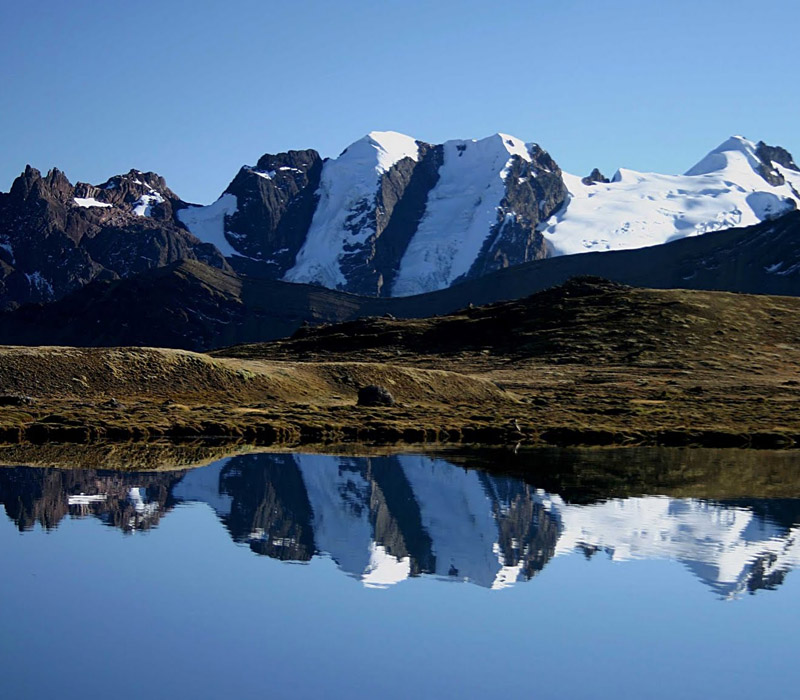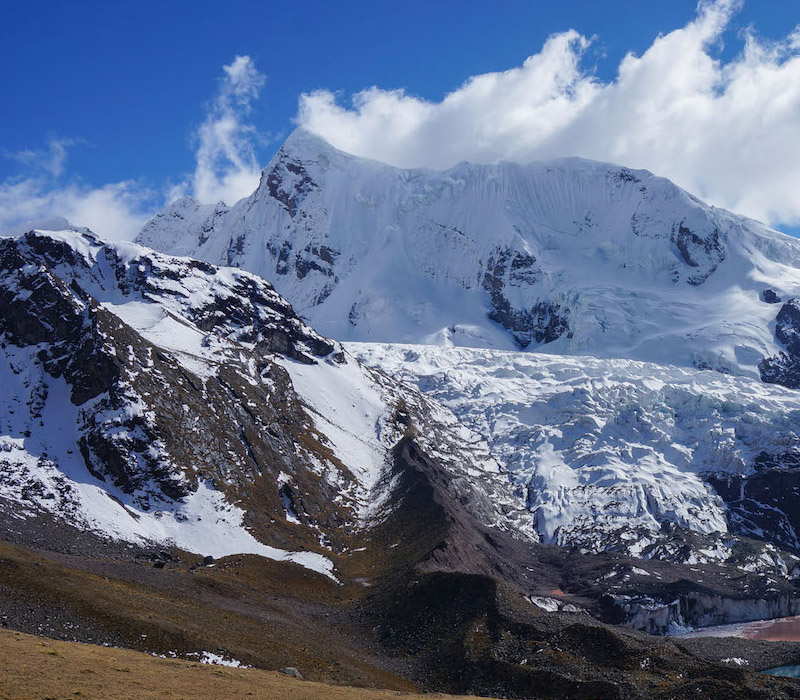Ausangate Sibinacocha Trek 6 Days

This amazing trek runs next to the spectacular snow-capped “Apu” of Ausangate (6.372m/20900ft) and takes you over mountain passes, awesome mountain scenery, remote Andean villages, hot springs and turquoise lakes. This alternative route to the classical circuit around Mount Ausangate still offers the most spectacular views of this sacred Andean mountain before it deviates towards the impressive Sibinacocha Lagoon, leaving tourist crowds behind and entering an almost uninhabited area in which one has the very special impression of being in the closest contact with nature. The hike ends in Phinaya, a small and remote Andean community with just horses and bicycles as sole transportation means. This is an unforgettable hike recommended for lovers of high mountain trekking searching for an intense experience in still untouched areas and wild, extreme nature. This is also one of the very few treks in the world, which allows to spot wild vicuñas in its natural habitat.
Day 1 Cusco to Qomerqocha Lagoon
Very early we leave the city of Cusco in a private transport, and drive along the Cusco – Puerto Maldonado highway in the direction of Pacchanta (4100m/13448ft). On the way we pass through Urcos, where we may spot a beautiful lagoon with the same name, continue on to Cattca, an agricultural and cattle raising community where we can appreciate the region’s spectacular views, Ocongate, capital of the district with the same name and finally cross Tinki, a small community already enjoying impressive views of Mount Ausangate, located only half an hour away from our destination. After an approximated 4,5 to 5-hour drive, we arrive in Pacchanta, a rural community that boasts some well-known hot springs where we can enjoy a nice dip with awesome views of the faces of Ausangate. At this point we meet our wranglers and horses and enjoy a first delicious lunch. In the afternoon we follow our hike through a slight climb up the Pacchanta valley, having the chance to spot llamas and alpacas, until we reach the beautiful Qomercocha lagoon where we set our camp and have dinner. Our campsite will be set in a spectacular spot with amazing views of Ausangate, Santa Catalina, Maria Huamantiqlla, Pucapunta and Colquecruz snow-capped mountains.
Day 2 Qomerqocha Lagoon to Yanamayo
We leave at around 6.00 am and continue on towards the first mountain pass of our trek, the Abra Q´ampa at 5000m/16400ft, which we will reach after about 4h. We then descend towards the Ticllaqocha Lagoons, a beautiful group of little turquoise lagoons next to which we have lunch. In the afternoon we continue our hike for an additional 2-3h until we reach Yanamayo where we set our camp in an impressive valley overlooked by the stunning Tres Picos, Colquecruz and Pucapunta peaks.
Day 3 Yanamayo to Condorpaso
We leave camp and start a gradual climb up toward Yanaqocha or “Black Lagoon” its name being due to the dark color of its waters. In this area we can appreciate a soil of volcanic origin, its color turning to dark red and black, as well as moraines, showing the previous presence of glaciers in this region. We will go over Yanaqocha mountain pass (5050m/16564ft) to then discover a surprisingly beautiful valley with an explosion of colored mountains, three spectacular lagoons and the presence of llamas and alpacas, which we will cross to head towards our next mountain pass (5100m/16728ft). From this point, an additional hour of hike leads us to Condorpaso, our next campsite, located very close to the mountain pass of the same name which will be our challenge for the next day.
Day 4 Condorpaso to Source of Sibinacocha Lagoon
After breakfast, we continue on a gradual climb up the valley that takes us to the mountain pass Abra del Condor (5200m/17056ft) after an approximated two-hour walk. From the pass, the highest point of our trek, we may not only enjoy spectacular views of the Vilcanota mountain range and the Sibinacocha Lagoon, our next milestone, but also hopefully see wild vicuñas. Immediately, we continue our hike for an additional 3 hours, crossing another mountain pass on the way and then descending into the valley of the Sibinacocha Lagoon’s source. We will camp next to the lagoon and very close from its source, where an impressive glacier stands and nourishes the lake with its turquoise waters that contrast with the dark blue pure color of the lagoon. The lagoon boasts a wide bio-diversity, we will most probably be able to spot Andean Coots, “Huallatas” or Andean Geese as well as Andean Ducks from our camp.
Day 5 Source of Sibinacocha Lagoon to Ccascana
Today, we depart early to walk along the shores of the Sibinacocha Lagoon for 3h until we reach the Yayamari community, next to the mountain of the same name, an impressive rocky peak overlooking the lagoon (5500m/18040ft). We then continue across a pampa where we will most probably see hundreds of llamas, alpacas and hopefully vicuñas, to then follow towards the Abra Ccascana at 5000m/16400ft, which will lead us to the lagoon of the same name, in which area we will set our last camp. In this remote spot, surrounded by impressive snow-capped peaks such as Montura and Chumpi and inhabited by small rural communities, we may have the chance to spot ¨Huallatas¨ or Andean geese and maybe even flamingoes.
Day 6 Ccascana to Phinaya and back to Cusco
After our breakfast, we leave Ccascana to walk for three and a half hours towards Phinaya. This is a small Andean community with a beautiful little church and no presence of vehicles except bikes and horses, where we will have lunch. In the afternoon, we meet our private transport that will drive us back to Cusco, where we expect to arrive after nightfall.
Departure dates
Daily departures are available along the year although due to weather conditions, the recommended period for this trek is April to November.
All private service departure dates are adapted to your request.
What is included
- Pre-departure briefing
- Collection from your hotel in the morning and transfer in private transport to Pacchanta, starting point of the trek
- Tinki visitor fee
- Campsite fees
- Personal tents: 2 people in each 4-people-capacity tent, to allow for higher comfort and a safe keeping of backpacks. The tents employed for treks around the Ausangate area are 4-season Eureka K2XT, highly maintained to ensure an excellent performance in field
- One inflatable sleeping pad per person
- One sleeping bag per person if requested: our sleeping bags are -18ºC-comfort (0ºF), mummy form and include a sleeping liner. They are cleaned after every use and have a maximum usage of 30 trips
- One pillow per person
- Dining tent with tables and chairs
- Kitchen tent
- Toilet tent with biodegradable toilet facilities
- English speaking professional and official tourist guide (2 guides for groups of over 8 people)
- Chef and cooking equipment
- Pack animals (to carry tents, food and cooking equipment)
- Pack animals to carry personal gear up to a maximum of 9kg per person (including sleeping pad and sleeping bag)
- 1 emergency horse every 6 persons
- Wranglers
- Accommodation for all our staff
- Meals (05B, 06L, 05D + daily morning snack + daily tea service except last day). Vegetarian or special menus are available at no extra cost
- One textile snack bag per person, to avoid the usage of plastic bags that contaminate our environment
- Filtered boiled water from lunch time on 1st day onwards
- Bio-degradable personal hand soaps
- Bio-degradable dishwashing detergents used by our kitchen staff
- Others: hot water every morning and evening for washing purposes / boiled water to fill in your water bottle every morning and night, and at lunch time if requested with enough time ahead
- First-aid kit including emergency oxygen bottle
- Private transport from Phinaya to Cusco, including transfer to your hotel in Cusco
24-h guest service: please ask for the emergency number available during your time of visit
What is not included
- Breakfast on the first day, dinner on the last day
- Tips: please beware that our agency staff is well paid so please feel free to tip or not as you wish
What we recommend that you bring
- A backpack with a change of clothes for the whole period of the trek
- Rain gear (jacket and pants if available) or rain poncho (plastic ponchos can be purchased in Cusco)
- Strong footwear, waterproof trekking boots recommended
- Sandals or jogging shoes for a higher comfort while at camp
- Warm clothes, including jacket, fleeces. Thermal clothing is also recommended, especially for sleeping. A down jacket is especially recommended for this trek since it runs at high altitude and temperatures may easily drop below freezing in the evening and at nights.
- Flashlight/headlamp and batteries
- Camera and batteries (batteries consume more quickly under cold conditions)
- Hat or cap to protect you from the sun, rain and cold
- Sun block
- After-sun cream or hydrating cream for face and body
- Toilet paper and tissues
- Snacks: biscuits, energy bars, chocolate, raw fruits, muesli, etc. Please beware that we do provide a daily morning snack and our meal service is very complete and well supplied. This recommendation applies for all clients being used to a specific snack, as it may happen that it is not included in our selection
- Water container and water for the first morning
- Optionally: water- sterilizing tablets in case you pick up water from streams or rivers along the route. Otherwise, we provide filtered boiled water, which is safe to drink and has not reported any health problem so far
- Small towel
- Swimsuit (if you wish take a dip at the hot springs along the route)
- Cash in soles and/or US$
- Copy of original passport
- Optional: walking sticks or poles



